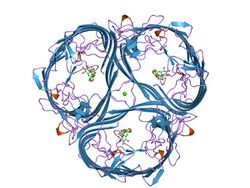Biology:Maltoporin
| LamB porin | |||||||||||
|---|---|---|---|---|---|---|---|---|---|---|---|
 Structure of maltoporin from Salmonella typhimurium.[1] | |||||||||||
| Identifiers | |||||||||||
| Symbol | LamB | ||||||||||
| Pfam | PF02264 | ||||||||||
| InterPro | IPR003192 | ||||||||||
| SCOP2 | 2mpr / SCOPe / SUPFAM | ||||||||||
| TCDB | 1.B.3 | ||||||||||
| OPM superfamily | 32 | ||||||||||
| OPM protein | 2mpr | ||||||||||
| CDD | cd01346 | ||||||||||
| |||||||||||
Maltoporins (or LamB porins) are bacterial outer membrane proteins of the porin family. Maltoporin forms a trimeric structure which facilitates the diffusion of maltodextrins across the outer membrane of Gram-negative bacteria. The membrane channel is formed by an antiparallel beta-barrel.[2]
Most pores used for diffusion contain only 16 antiparallel strands, but maltoporin has 18. The structure of maltoporin contains long loops and short turns. The long loops are in contact with the cell exterior and the turns are in contact with the periplasm. This channel is involved in sugar transport. The sugar initially binds to the first greasy residue with van der Waals forces. The sugar continues through the channel by guided diffusion of the sugar along the greasy residues which form a "slide".[3]
Maltoporin's original name was LamB because it is a bacteriophage lambda receptor. This channel is specific for maltosaccharides, whose affinity for the channel increases as the length of the chain increases.[3]
References
- ↑ "Structure of maltoporin from Salmonella typhimurium ligated with a nitrophenyl-maltotrioside". J. Mol. Biol. 266 (4): 761–75. March 1997. doi:10.1006/jmbi.1996.0823. PMID 9102468.
- ↑ "Structural basis for sugar translocation through maltoporin channels at 3.1 A resolution". Science 267 (5197): 512–514. 1995. doi:10.1126/science.7824948. PMID 7824948.
- ↑ 3.0 3.1 Ranquin, An; Van Gelder, Patrick (October 2004). "Maltoporin: sugar for physics and biology". Research in Microbiology 155 (8): 611–616. doi:10.1016/j.resmic.2004.05.007.
 |

